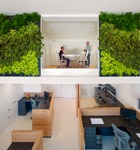It was the Hanging Gardens of Babylon that were a wonder of the entire ancient world, but the hanging gardens of Buck O’Neill Builders are still at least a small marvel in the firm’s San Francisco headquarters. The 1,600-square-foot office, which is nearly complete, will achieve LEED Silver or Gold certification, and its innovative air system is far from its primary green feature. “We’ve gone through great efforts to think outside of the box on this project,” firm president Buck O’Neill says.
The office’s wooden cubicle cladding reuses 100 percent of the demolition material from a LEED residential project also under construction by the firm, and 98 percent of the interior finishes are zero-VOC. The floating wood staircase is constructed of 100 percent locally reclaimed wood—from Petaluma, California, O’Neill says—and the finishing touch of the staircase is a 3’ x 4’ landing made from the endgrain of a reclaimed tree. A contractor friend offered the lumber at the point of demolition, and O’Neill snapped it up, noting that it resembles the endgrain in the company logo.

All of the wood cladding for Buck O'Neill's office cubicles were salvaged from a home the company is building in San Francisco. Photo: Bruce Damonte.
Designed by Buck O’Neill and fellow contractor Chris Whitney as a vertical vegetable garden, the plant biofilter operates as a pair of hanging sections that will purify indoor air. O’Neill says he is not aware of a similar system anywhere in San Francisco. Though the biofilter does not fit any of the standard LEED criteria, O’Neill is hoping that the system will be recognized for its ingenuity.
“It’s not like this has never been done before; it’s just never been done to this extent for something like a small office,” he says. The system consists of two panels of vertically suspended hydroponic plants, and a system of baffles and fans draws air through the office and into the biofilter. “In theory, the toxins in the air from a standard office environment, which the plants thrive on, will attach to the roots of the plant,” O’Neill says. “Then the clean air moves back out to the office. Once I have the office indoor air quality tested, that will show us if our efforts have worked.”

This floating staircase was built from reclaimed timber. It also uses a no-VOC finish. Photo: Bruce Damonte.

In the bathroom, the builders used cork penny tile, cork for the flooring, and a low-flow faucet and toilet. Photo: Bruce Damonte.
The sleek office design represents a change of pace for the building firm, which specializes in residential renovations. “Historic housing is what we do; it’s our bread and butter,” O’Neill says, “but it was nice to do the office in an ultra-modern style.”
The firm’s historic housing projects include one O’Neill has nicknamed The Castle. Once owned by the colorful “Sunny Jim” Rolph, San Francisco’s mayor from 1912 to 1931, the Tudor-style mansion was said to house his mistresses. “The thing I love about it is the owners are going to live the rest of their lives in that house,” O’Neill says. “That actually doesn’t happen for us that often here in the Bay.”
Self-performing nearly all carpentry and minimizing the use of subcontractors means that O’Neill keeps prices competitive. Yet with the historic-housing requirements imposed by city codes, replicating vintage elements is often no small feat. “That has been one of the big, painstaking aspects,” O’Neill says. “If we remove something, we have to replace it as we took it off. [On one Edwardian-era mansion], we actually had to go through and create an entire photo plan of all of the aspects of all of the elevations of the house. … We referenced this plan, per window per square foot of this house, to build it exactly in kind.”
O’Neill says his goal is a lifetime of sustainable construction. “Let’s say I make it to 80 years old,” he says. “I would like to look back on my life and say that I built this way, that our projects were responsible, that I succeeded in offsetting.”

